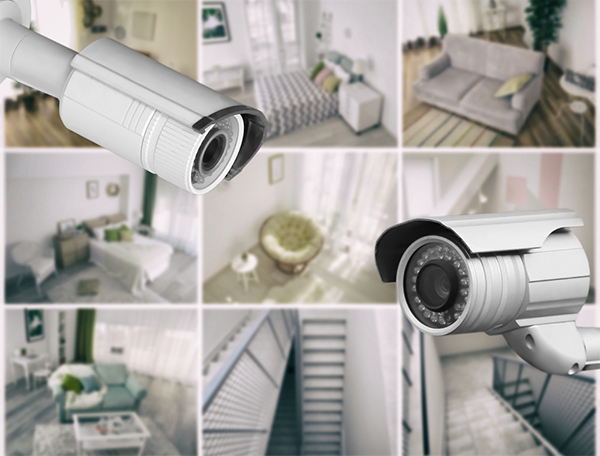Did you know that Australia has the 7th highest burglary rate in the world?
With more than 4% of Australian households having experienced a break in or attempted break at some point within the last year, the threat of a home break in is ever present.
“We never thought it would happen to us.” is something we hear time and time again from homeowners who thought their home wouldn’t be targeted. Only for them to suffer a break in which prompts them to shore up security around the home after the fact – too late.
Rather than picking up the pieces following a break in, it’s better to take proactive measures to deter thieves from targeting your home in the first place—and installing security cameras is a great way to do that.
If you’re considering installing security cameras, this guide shows you how to get your security camera placement right, so you can enhance the security of your home and stop thieves in their tracks.

Security cameras are proven to deter thieves
While security cameras can’t prevent 100% of crime, numerous studies have shown that security cameras are an effective tool in deterring burglars—and it makes sense. When thieves are choosing which home to target, they look for ‘soft targets’, or properties that are relatively easy to gain access to. Those where they’re unlikely to get caught.
Every defensive or protective security measure you employ to enhance security around the property (including installing security cameras) will make the home a less appealing target, and make thieves more likely to pass it by. Even if you do still fall victim to a burglary, at least your security cameras will be able to capture valuable footage which can be used to identify the perpetrator/s and lead to a conviction.
Deciding where to place your security cameras
It’s easy to assume that any security cameras are better than no security cameras, but in reality, a poorly designed or installed security camera system which fails to capture important visuals is practically useless.
When deciding where to place your security cameras, there are a few key things you need to consider to ensure the system is reliable and effective.
Main entry points
It’s essential that your camera system captures footage of each main entry point to the home.
Nearly 80% of burglars enter through either the front door, back door or a first-floor window, so ensuring you have adequate coverage of these areas should be a top priority. Depending on your home, it’s also important to consider any other possible entry points to the premises, such as a garage, basement or upstairs balcony.
Points of vulnerability
Every home is different, and it’s important to consider any areas which could make the property more vulnerable.
Things like a vacant block next door, fences that back onto walking tracks or parkland, a garage that opens onto to a laneway or alley, any areas with low visibility from the street or other houses, or places where intruders have gained access to the property previously could all be considered points of vulnerability which require additional coverage.
Privacy
While the rules around surveillance in private residential settings in Australia vary according to the individual state or territory, it’s generally considered illegal to film someone in their home without their prior consent.
It’s important to keep this in mind when choosing where to place security cameras, as a camera pointed directly into a neighbour’s home could be in breach of privacy legislation. The same rules also apply to security cameras, hidden or overt installed in bedrooms and bathrooms.
Security camera placement tips
There are also plenty of other things you’ll need to consider when deciding where to place your security cameras. Here are some other valuable tips that will help you choose the most suitable locations for your cameras:
- Cable access – You’ll need to identify locations where it won’t be too difficult to cable and run wiring to connect each camera to a power source and to the recorder. In many cases where cabling is impossible you can locate a camera in a more accessible location and then use longer focal lengths or ‘zoom’ to show the desired picture.
- Street visibility – Ensure your cameras are clearly visible from the street to deter thieves from targeting your home and send them elsewhere.
- Height of installation – It’s important to install your cameras high enough that they can’t be easily tampered with. However they also need to be low enough to capture faces, not the tops of heads and be accessible for cleaning. Vandal proof camera housings allow you to mount cameras lower (better for capturing faces) but avoid them being disabled. Building and cabling realities often impact the ultimate height but generally from 2 to 4 metres above floor level is a minimum height.
- Camera angles – Consider what visuals you want to capture when setting the angle for each camera. Are you trying to capture a face, or a car’s licence plate details? In most cases, you may require more than one camera in an area to adequately capture everything with suitable clarity and avoid blind spots.
- Lighting – While many commercial-grade security cameras are equipped with Wide Dynamic Range and High Dynamic Range (HDR) which allows them to automatically adapt to handle difficult lighting conditions, many cheaper residential-grade cameras lack this technology. In this case, you’ll need to check for any backlighting such as a camera facing into the afternoon sun which could affect the level of exposure and picture quality. Make the necessary lighting adjustments to ensure a good quality picture in all conditions, day and night.
- Protection from the elements – Depending on where you live, your cameras may be subjected to rain, snow, moisture, dust and dirt. While most outdoor cameras are considered ‘weatherproof’, they may still be vulnerable to some extreme Australian weather conditions. For this reason, it’s a good idea to install them in locations where they’ll be somewhat protected from the elements to extend camera longevity and useful picture between cleanings.
Let us take care of the leg work
Getting your security camera placement right can be tricky, so rather than stumbling your way through it, why not call in the experts. You tell us what you’re trying to view and we make it happen.
At Calamity, our experienced security professionals can offer their expert advice to design a first-rate security camera system for your home and provide round-the-clock monitored protection from our state of the art Australian security facility. We’ll recommend the optimal camera placement to provide a superior level of protection, then take care of the installation, programming, commissioning and training for you.
Currently protecting tens of thousands of individuals, our security expertise is second to none, and you’ll have complete confidence that your home will always be safe and protected from intruders.
Find out more about our home security solutions or contact us to request a personalised consultation.

